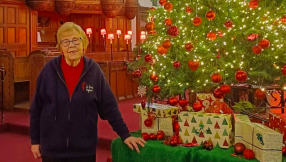
In spring 2019, long before Covid-19 was in the national consciousness, I wrote an article exploring Church in the digital age.
But I must admit that for me, as for many people, digitised church services have always been something on the periphery of church life. They were a comforting plan B if we couldn't physically make it to church. In the article, I encouraged churches to invest their time exploring them, but I didn't imagine they'd play such a crucial role in the lives of the majority of churches a year later.
Well, of course over the past couple of weeks reality has changed swiftly. Right now, digital church is the way that many are choosing to continue operating. And although in the past I've tuned in to life groups and prayer meetings remotely many times, last week I had my first fully digital life group – by which I mean every single attender was in their own home and addressing the others through Google Hangouts. We also had a digital service on Sunday and the children's pastor will be recording a message for the kids to replace the children's groups.
So how does church activity in this format compare with physical meetings, and why should we invest in them more?
I mentioned several pros and cons of digital activity in my earlier article and some of those still hold true. But right now, online activity is actually the best expression of community we have, and is helping to stave off feelings of isolation and loneliness rather than encouraging them.
It's digital platforms that are meeting our needs for community, encouragement and sharing in faith. For my own group, we were able to pray together, chat and share thoughts on a message pretty much as normal. We watched an online video about the day's topic and even worshipped together – it was much like listening to a worship song on YouTube and singing along, except we were still in community as we could see each other.
One thing I appreciate about the format is that it does hold in tension both a sense of shared experience with those you're online with and a layer of privacy – you're still you in your own home with no one else 'there', and though people can see and hear you, you are in control of that. You can manage your attendance of the group around other home-based practical tasks, and you may find you have more freedom to react differently to the teaching material, make notes and grab a relevant book from the shelf without feeling like you're distracting anyone. It does give a sense of freedom which – even outside our current situation – many members of the community really benefit from, such as nursing mothers or those with social anxiety or disabilities.
On the other hand, though, someone might find they have more 'freedom' to go and make a cup of tea midway through. It is easier to get distracted during digital services, and there are other problems. Sadly one member couldn't join as their computer wasn't loading the software, and even for us who had it there were minor technological issues. Of course, as amazing as technology is, it's never going to be as reliable a way of communicating with someone as simply being in the same room as them.
However, the more digitally literate churches become, hopefully the less technological problems will be a barrier. Digital literacy is becoming (and right now, simply is) a vital skill that enables us to serve others. Of course, what is important for serving is the heart more than skills. But, just as we need to be able to read in order to preach, and to cook in order to feed the hungry, so we need to have awareness of how to use digital platforms and how to fix problems in order to host people digitally.
I am confident that, during this period of social distancing, churches will rise to the challenge by increasing their digital skills and seeing the value of being flexible about the way they minister, which will help them better serve their communities' needs beyond this time. But having said that, if a church isn't able to digitally produce a Sunday service, there is still the option of encouraging families to come together to have church at home.
Another message that this online-only season is really hammering home to me is that the church isn't a building or a place, it's a people. We may have heard this many times, but it's more important to remember that now than ever. We may not be able to gather together or even set foot in a church building for weeks, but we don't have to let that prevent us from being church.
Matthew 18.20 indicates that as few as two are needed to form the church, and God's presence isn't so limited that it requires physical proximity. So stay safe – but stay connected.
Hannah Stevens is a writer and works for a Christian charity













